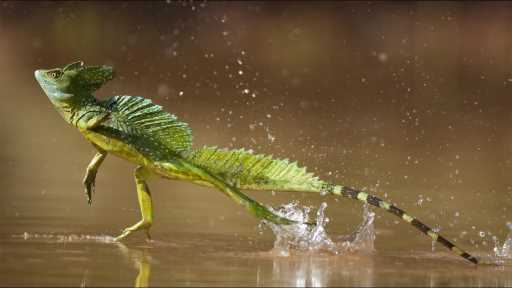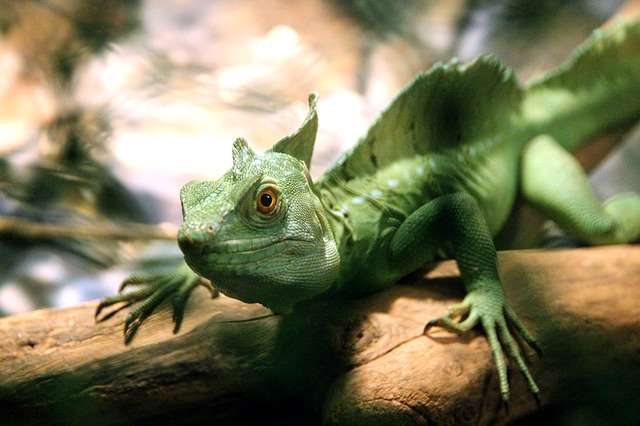
Characteristics, what do basilisks eat? reproduction, it runs on water, what prevents it from sinking?
The Jesus Christ or Basilisk lizard also goes by other names, such as Jesus lizard, cherepo or gallego (Costa Rica), moracho or meracho (Panama), toloque or teterete (Mexico), piandes (Ecuador), and pasarroyos (Colombia).
This lizard belongs to the family Corytophanidae, of the genus Basiliscus, to which several species belong, such as B. basiliscus, B. galeritus (red-headed), B. plumifrons (green or double-crested), and B. vittatus (brown with stripes), all sharing some characteristics, such as habitat (tropical rainforest from Central America and southern Mexico to some regions of northwestern Colombia, Ecuador and Venezuela), or the presence of at least two ridges or sails, as well as other aspects of its morphology.
The name of the genus Basiliscus comes from the Greek basiliskos, which means small king, due to its crest on the head and its elegance and mobility.
▷ Basilisk Lizard features
The species Basiliscus basiliscus measures 70 to 75 cm, including the long tail, and can weigh from 200 to 500 g. It resembles the iguana, but its body is more upright and slender.
This lizard grows according to seasonal variations, especially in the distribution of rainfall in its habitat, to which it is very sensitive. Likewise, its growth is affected by social interaction with other individuals (Van Devender 1978).
It has three crest-shaped sails: on the head, back and tail and it moves with great ease.
Its skin is brown or olive in color, with the ability to modify it with green or yellow shades. It has small light yellow lines on the underside of its body, and three longitudinal lines on its throat.
Another characteristic of the basilisk, and of its genus, is that it can flee from predators by opening a hole in the sand to hide.
To keep sand out of their nostrils, they have a ring of muscles that they close to protect themselves.
What do basilisks eat?
Its diet is omnivorous, mainly insectivorous, but it also eats meat, such as fish, frogs or other small lizards. Their diet is generally insects, flowers, fruits, tender stems, and eggs.
▷ Reproduction of the basilisk lizard
Sexual maturity of this lizard begins near the end of its first year of life. Individuals of different sexes are attracted to each other by secretions from glands located in their tails.
When fertilized, the female lays three to four units of eggs per year, each unit consisting of 10 to 20 eggs. Once laid, the female abandons the eggs, which begin to hatch about three months later.
▷ Basilisk runs over the water.
The most notable characteristic of the B. basiliscus is its ability to run on the surface of the water. That is where the name Jesus Christ lizard comes from.
According to the Gospel of Matthew, Jesus Christ performed the miracle of walking on water. That is precisely what this lizard does.
But not only this creature can do this. Also afloat on the surface of the water are some aquatic birds, such as the achichilique, some spiders, the Brazilian geo pygmy gecko (which has hydrophobic skin that repels water), and dolphins, which perform certain movements that look like they are playing by walking backwards in the water.

▷ What keeps the basilisk lizard from sinking?
This ability of the basilisk to walk, or rather run, on water is due to the physical principle known as surface tension, which is due to the cohesive forces that act on the molecules of any liquid to hold them together.
The basilisk, when running in a hurry, takes advantage of a sort of interface between air and water, turning the water into a trampoline (Glasheen, Mcmahon 1996).
It runs very fast on the surface of the water, taking advantage of the fact that its hind legs have a kind of dermal fins or lobes that open, increasing its support surface.
If it stops running, it sinks in water, and must swim like other lizards. This is not a problem for the basilisk because it can remain submerged in water for up to thirty minutes.
When it is on land, it wraps these “fins” around its body. But it only takes advantage of this ability to run on water when running fast, without stopping, which it can do for about two minutes.
Bibliography
- Glasheen J, Mcmahon T (1996). Size-dependence of wáter-running ability in basilisk lizards(Basiliscus basiliscus). Journal of Experimental Biology, 199, 2611-2618.
- Van Devender R.W. (1978). Growth ecology of a tropical lizard, Basiliscus basiliscus. Ecology, Vol. 59 (5), 1031-1038.

Dr. Rafael Cartay is a Venezuelan economist, historian, and writer best known for his extensive work in gastronomy, and has received the National Nutrition Award, Gourmand World Cookbook Award, Best Kitchen Dictionary, and The Great Gold Fork. He began his research on the Amazon in 2014 and lived in Iquitos during 2015, where he wrote The Peruvian Amazon Table (2016), the Dictionary of Food and Cuisine of the Amazon Basin (2020), and the online portal delAmazonas.com, of which he is co-founder and main writer. Books by Rafael Cartay can be found on Amazon.com
This post is also available in:
![]() Español (Spanish)
Español (Spanish)

